That would work, but you don't need RL. Also (of course), Vout be negative for positive Vin.
Your two 10 kohm resistors cause the zener to see half of \$V_{in}\$. So, the trip point for \$V_{in}\$ is not the zener voltage itself, but twice of it (16.4 V). The equation for \$V_{in}\$ < 16.4 V is exactly the same as if the zener wasn't there. So, you would have two 10 kohm resistors in series.
\$V_{out}=-V_{in}\dfrac{100,000}{20,000}=-5V_{in}\$ , for \$V_{in}\$ < 16.4 V.
If \$V_{in}\$ >= 16.4 V, then you just have a constant voltage source, of 8.2 V, applied to an amplifier with G=-10.
\$V_{out}=-82\$ V, for \$V_{in}\$ >= 16.4 V (assuming the opamp were able to deliver that output voltage, which is not the usual case).
(Note that the two equations converge, for \$V_{in}\$=16.4 V.)
Also, if \$V_{in}\$ can be high, but not very very high, you may not need a diode, because the input resistors (20 kohm in your case) limit the input current, and therefore the damage that you could do to the circuit. What is the maximum Vin you would like to work with?
